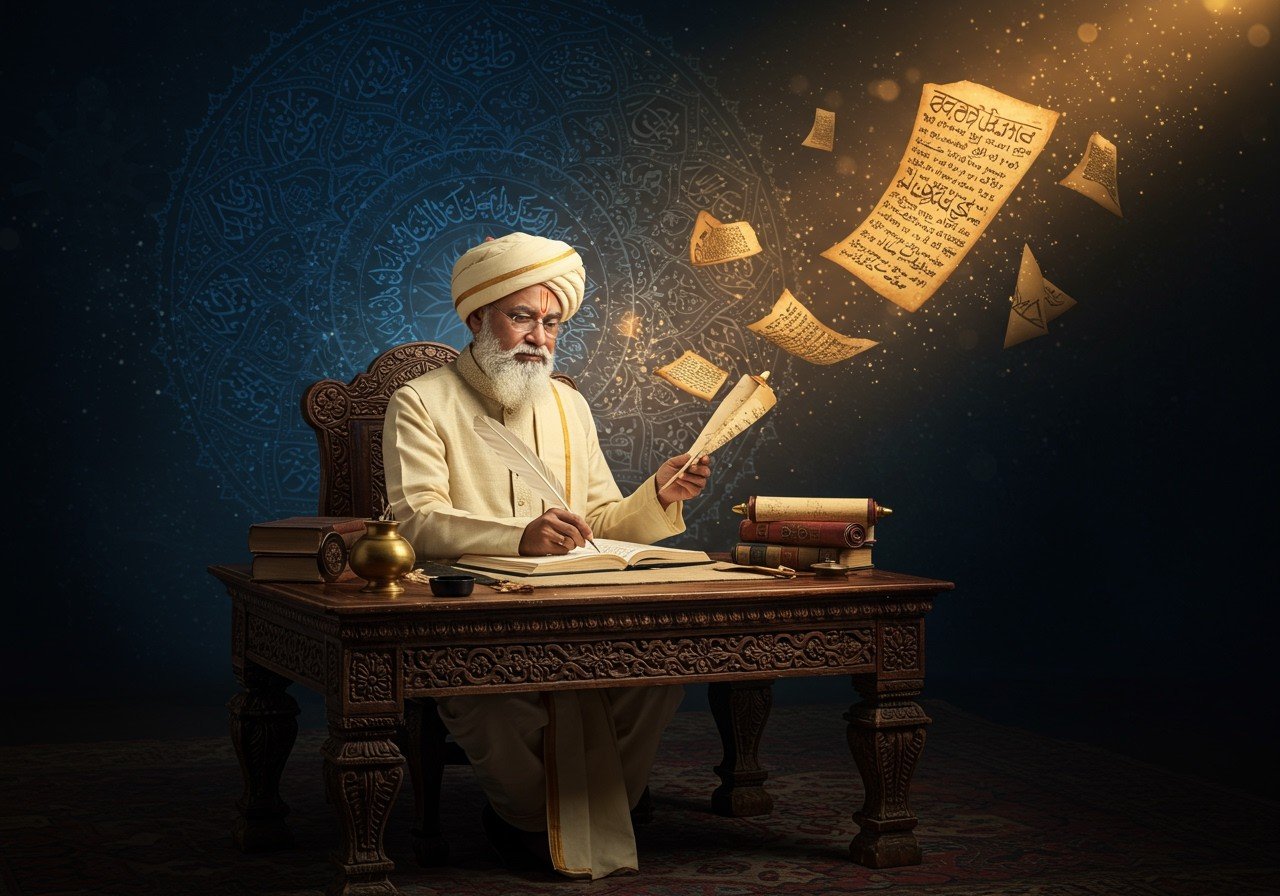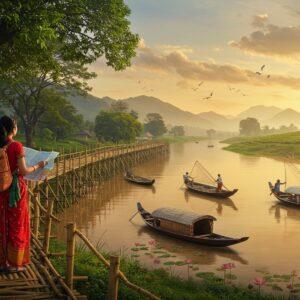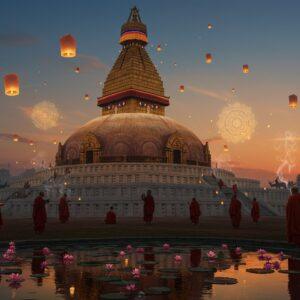
In India, the caste system has profoundly shaped communities for centuries. Among these, the Kayastha community occupies a unique and respected position. This blog delves into the rich cultural heritage and evolving identity of the Kayasthas, offering valuable insights into their historical context, cultural nuances, and significance in Indian society.
A Journey Through Kayastha History
The Kayastha lineage traces back to the heart of ancient India. Serving as scribes and administrators, they played a pivotal role in the courts of medieval kingdoms, shaping the course of history with their knowledge and skills. These custodians of knowledge meticulously maintained records and managed complex administrative duties, their influence deeply embedded in the administrative and literary landscapes of the time. Their contributions are etched in historical texts, testament to their vital role in society.
Across the centuries, the Kayastha identity has gracefully evolved, adapting to changing times while preserving its core values. Their historical journey, marked by intellectual prowess and unwavering dedication, has shaped their modern significance, making them a respected community in contemporary India. To understand the Kayasthas is to grasp a significant thread in the intricate tapestry of Indian history.
- You can explore more about ancient Hindu history on poojn.in. Explore the captivating history of Hinduism and gain a deeper understanding of its ancient roots and cultural significance.
- Discover a concise overview of Hindu origins here. Delve into the fascinating narrative of Hinduism’s development and gain valuable insights into its core principles.
Cultural Threads: Traditions and Significance
The Kayastha community boasts a vibrant cultural tapestry, woven with unique traditions and customs passed down through generations. Their rich heritage comes alive in their heartfelt celebrations and rituals, each carrying deep meaning and cultural significance.
Chitragupta Puja, a central festival for Kayasthas, is celebrated with immense devotion and reverence. It honors Chitragupta, the divine record-keeper in Hindu mythology, embodying the community’s historical association with writing and administration. On this sacred day, Kayasthas pay homage to the tools of their traditional profession – the pen, paper, and inkpot – recognizing them as symbols of knowledge and wisdom. This beautiful tradition underscores their respect for learning and their enduring connection to their historical roots.
Family values form the bedrock of Kayastha households, fostering a strong sense of belonging and mutual respect. Social customs emphasize unity and harmony, passed down through generations. Traditional attire varies across regions, adding a splash of color and diversity to their gatherings, showcasing the regional nuances within the community.
- Kayastha cuisine is another expression of their cultural identity. Traditional dishes, prepared with love and care, are not merely meals but a celebration of heritage and togetherness, passed down through family recipes and imbued with regional flavors.
- Art and literature hold a special place in Kayastha culture, reflecting their intellectual and creative spirit. The community has made significant contributions to Hindi literature, with their writings often mirroring societal dynamics and offering intimate glimpses into Kayastha life. Notable authors from the community continue to enrich Indian literature, keeping the flame of their cultural heritage burning bright.
Kayastha Identity in Contemporary India
Today, Kayasthas stand at the confluence of tradition and modernity, navigating a rapidly changing world while holding steadfast to their roots. Globalization and modernization have inevitably influenced their identity, yet their core values and cultural heritage remain strong anchors in their lives.
Education is highly valued within the Kayastha community and plays a crucial role in shaping their contemporary identity. Known for their academic achievements and professional excellence, they strive for success in diverse fields, contributing meaningfully to society.
- Kayasthas have made their mark in a wide range of professions, from politics and the arts to sciences and entrepreneurship. Their contributions are a testament to their adaptability and intellectual prowess, making them a respected presence in modern India. Prominent figures from the community serve as inspiring role models for younger generations, encouraging them to embrace progress while upholding their heritage.
- Preserving cultural heritage is a priority for Kayasthas amidst the dynamic shifts of modern society. The community actively engages in efforts to safeguard its traditions, ensuring they are not lost to the sands of time. By striking a balance between modern influences and traditional values, Kayasthas maintain their unique identity in a world that is constantly evolving.
Kayasthas in the Realm of Hindi Literature
Hindi literature offers a powerful lens through which to understand the Kayastha community’s essence. Stories and narratives often depict the challenges they have faced and the triumphs they have celebrated, providing valuable perspectives on their journey through history and their place in Indian society.
Kayastha authors have played a vital role in enriching Hindi literature, bringing to life the cultural richness and complexities of their community. Their words paint vivid pictures of Kayastha life, giving voice to their experiences and preserving their heritage for posterity. Through the power of storytelling, they continue to shape perceptions and ensure that their legacy endures.
Understanding the Kayastha Caste Classification
The question “Kayastha which caste?” often arises due to their unique position within the traditional caste hierarchy. Some consider them a distinct Varna, created specifically to maintain records for the other four Varnas. Others classify them as Kshatriyas or of mixed origin. This ambiguity itself adds another layer to the multifaceted Kayastha identity.
Regional variations within the community further showcase its diverse nature. The Chitraguptavanshi Kayasthas of North India, the Bengali Kayasthas of Bengal, the Chandraseniya Kayastha Prabhus of Maharashtra, and the Karanas of Odisha each possess unique customs and traditions, adding their own distinct hues to the broader Kayastha identity.
Understanding these nuances is key to dispelling misconceptions about the Kayastha caste. Recognizing their rich diversity and appreciating their contributions to Indian society provides a more complete picture of their significance in the nation’s cultural tapestry.
How Poojn.in Supports Kayastha Traditions
Poojn.in takes pride in being a reliable online resource for Kayastha families seeking authentic ritual items and religious materials. We deeply understand and respect the unique cultural heritage of the Kayastha community. We are committed to providing all the essential items required for traditional ceremonies and daily worship.
Our platform offers a thoughtfully curated selection of puja items specifically relevant to Kayastha rituals:
- Pure copper and brass utensils: We offer a range of ghats and other utensils crafted from pure copper and brass, essential for maintaining the sanctity of sacred ceremonies.
- Traditional puja thalis: Discover beautifully designed puja thalis crafted according to Kayastha customs, adding a touch of tradition and elegance to your rituals.
- Authentic Gangajal: We source authentic Gangajal from holy sites, ensuring the purity and sanctity of your religious practices.
- Sacred threads and religious accessories: Find a wide array of sacred threads, dhotis, and other religious accessories essential for Kayastha ceremonies and rituals.
- Clay diyas: Illuminate your puja space with our beautiful clay diyas, handcrafted with care and tradition.
For Kayastha families residing in modern urban environments, Poojn.in offers the convenience of maintaining cultural practices with ease:
- Doorstep delivery: We provide reliable doorstep delivery across India, bringing the sanctity of tradition right to your home.
- Quality assurance: All our products are quality-checked to ensure authenticity and meet traditional specifications.
- Regional language support: Detailed product descriptions are available in multiple regional languages, catering to the diverse linguistic landscape of India.
- Expert guidance: Connect with our knowledgeable team via WhatsApp (9476142738) for personalized assistance in selecting the perfect items for your specific needs.
- Phone support: Our dedicated customer service team (03369029784), well-versed in Kayastha customs, is available to answer any ritual-related queries you may have.
Visit Poojn.in or contact us on WhatsApp to explore our comprehensive collection of traditional puja items, thoughtfully curated for Kayastha households.
Conclusion: A Legacy of Tradition and Progress
The Kayastha community stands as a vibrant testament to the rich tapestry of Indian culture, gracefully balancing tradition with the dynamism of modern life. Their cherished customs and rituals, exemplified by the revered Chitragupta Puja, reflect their deep-rooted values and profound connection to their heritage.
In today’s world, Kayasthas continue to excel in various fields, carrying their legacy of intellectual pursuit and professional achievement forward with pride. They embrace progress while honoring their heritage, a testament to their adaptability and enduring spirit.
Hindi literature serves as a powerful medium for portraying the nuances of Kayastha life, capturing their contributions to society and preserving their identity for generations to come. The exploration of their caste classification underscores the complexity and richness of their identity, further highlighting their integral role in India’s diverse social landscape.
FAQs: Delving Deeper into Kayastha Identity
What are the historical roots of the Kayastha caste? The Kayastha caste’s origins trace back to ancient India, traditionally linked to roles as scribes, administrators, and record-keepers, spanning various regions across the country. Their history intertwines with the development of administration and literacy in India. The earliest references date back to the Kushan Empire, where the term was used for writers or scribes.
Is the Kayastha caste considered a high caste? Yes, Kayasthas are generally regarded as a high caste, recognized for their historical emphasis on education, literacy, and administrative roles, contributing to their social standing.
How have Kayasthas contributed to Indian society? Kayasthas have historically held significant roles in administration, governance, and the judiciary, and their influence continues in various professional fields today. They were known as “writing castes” and were skilled in law, literature, court language, accounting, and litigation.
How do Kayasthas express their cultural identity? Kayasthas identify with rich cultural traditions, encompassing distinctive rituals, festivals, and culinary practices. Education and professional success are often emphasized within the community.
Is there a specific language linked to the Kayastha caste? Kayasthas speak different languages based on their regional location, reflecting India’s linguistic diversity. However, Hindi is commonly spoken among many Kayastha communities, serving as a unifying language. During the Mughal rule, they learned Persian and became integrated into the Indo-Muslim governing system, often serving as “Qanungos” (registrars).
What are some prevalent Kayastha surnames? Common Kayastha surnames include Srivastava, Mathur, Saxena, Nigam, and Asthana, among others, often indicating clan or regional origins.
Do Kayasthas have distinct religious practices? Kayasthas primarily follow Hinduism, participating in its diverse rituals and traditions. Additionally, they often observe unique religious practices passed down through generations within their community, including Chitragupta Puja, venerating the pen, paper, and inkpot.
Why is the Kayastha identity relevant in contemporary times? The Kayastha identity remains relevant as it highlights the community’s historical contributions to Indian society and their continuing influence in various fields, preserving their unique heritage in a rapidly evolving world.


